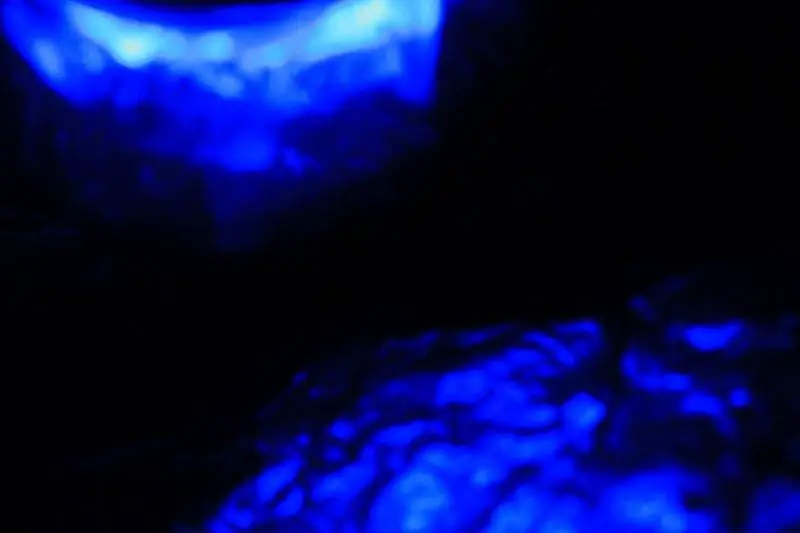Sunlight or what we call white light is made up of seven colors namely violet, indigo, blue, green, yellow, orange and red. Each of these colors has varying energies and wavelengths and when combined, they form a spectrum. The wavelengths and energies of light are inversely related. Simply said, the lights with shorter wavelengths possess more energy and those with longer wavelengths have less energy. The red light has a longer wavelength than the other rays in the spectrum, while the blue light has a shorter wavelength and carries more energy. There are many things that are blue found in nature, oceans and the sky being the most prominent, and we hope you now know why they appear blue?
Also called the blue-violet or the violet light, blue light is the visible light in the spectrum and falls in the range of 380-500nm. Over one-third of visible light is the high energy visible blue light.
Blue light is close to the UV rays in the spectrum of light, and just like the UV rays, blue light too comes with certain drawbacks and benefits. This write-up talks about some interesting blue light facts. Let’s explore them in detail.
Blue light is all over the place
Do you believe if we say that we are exposed to blue light most of the time? Yes, you read that right. Regardless of whether you stay indoors or outdoors, we are exposing ourselves to blue light every day, and most part of the day. To make it more clear, you are largely exposed to blue light if you spend most of your time outdoors, since Sunlight is the chief source of blue light. On the other hand, if you stay indoors but are glued to your TV screen, laptop, mobile phone or any other smart gadget, take note, they emit blue light too! However, you can minimize the effects associated with blue light if you reduce the usage of these gadgets.
High-Energy visible blue light makes the sky appear blue
Due to the energy levels the blue light possesses, it can easily scatter through the water molecules and air in the atmosphere. This is the reason the things that are blue in nature appear as they are, such as the sky and water bodies.
Your eyes cannot block blue light
Your eyes are so designed to naturally block the ultraviolet rays from entering deep inside. In fact, less than one percent of it can enter the retina. On the other hand, you cannot block the blue light naturally. It can go deeper, right through your retina and damage the cells within. If you are working under the Sun for prolonged hours or are compelled to use man-made digital devices that emit blue light for long hours, ensure to take extra protection.
Blue light significantly affects your sleep patterns
If you are finding it hard to fall asleep, maybe you are exposing yourself to blue light too much just before going to bed. Try to avoid using phones and/or watching TV a couple of hours before you go to bed. Blue light interferes with your body clock and tricks your brain into thinking it is not bed time yet. So, if you want to rest peacefully and have a good night’s sleep, keep away all your gadgets after dinner and try to be calm.
Man-made sources of blue light found in abundance
It is well known that Sun emits a lot of blue light. The man-made devices found in households today also emit blue light but it is negligible compared to the natural source. The problem is we humans tend to spend too much time on these gadgets. An average household today will have at least 3-4 gadgets and families, including small children stay glued to these devices all the time. The trend is dangerous and it is time we limit the usage.
Blue light is essential for plants
If you have a garden and grow plants regularly, you might know the color of light really matters to your plants. Gardeners often use artificial light to adjust the UV light and achieve optimized plant growth. When you use blue light just before the seeds sprout, it enhances the chlorophyll amount, helping them grow quickly. In fact, some seeds can’t sprout without getting exposed to blue light.
Blue light is widely used in the skincare industry
Blue light in recent times is widely used for providing certain therapies. It can elevate your mood and help you stay awake and focused when required. Blue light is also used to treat several skin conditions. It can reduce spots caused by over exposure to sunlight and work on enlarged pores to ultimately improve the tone and texture of your skin.
There’s yet another revolutionary blue light therapy. A skin cancer prevention treatment called the photodynamic therapy uses blue light to treat precancerous and cancerous skin lesions that haven’t metastasized. Blue light is used along with photosynthesizing medication to kill the targeted cells.
Treatment for seasonal blues
Some people suffer from a rare seasonal disorder. We are talking about a kind of depression where symptoms amplify during the colder months. If you are one among those people, we have some good news for you! You can undergo blue light treatment, wherein you will be exposed to blue light boxes that emit considerable amounts of blue light. These light boxes work like the sunlight and alter your brain’s chemistry, enabling you to stay calm, alert and focused. This therapy is considered effective and safe.
Blue light is not entirely bad
As the saying goes, too much of anything can be bad. The same applies to blue light exposure. While too much of exposure can harm your eyes and sleep, you need to get outdoors, under the Sun for some time every day. Things that are blue, including blue light help in improving your memory, alertness and cognitive function. It is also proved that blue light enhances the mood. Blue light in fact is essential to keep you healthy.
Too much of blue light may lead to macular degeneration
Macular degeneration is a condition where the light sensitive cells in the inner part of the retina get damaged. This is due to the continuous exposure of your eyes to the blue light. When the condition worsens, it may cause permanent vision loss. Research is being carried on to precisely find out how much man-made and natural light is harmful for the human eye. However, eye experts advice reduced usage of smartphones, tablets and TV to avoid falling in the risk category for macular degeneration.
Blue light causes eye strain
Since blue light contains high energies, it can scatter more easily than the other light rays. It is not observed. This happens particularly when you see the computer screen, TV, smartphone or any other digital device that emits blue light in significant amounts. This results in reduced contrast, eventually leading to eye strain, more commonly referred to as the digital eye strain. All things that are blue are not bad but it is certainly important to limit your exposure to those things that emit more blue light.
Blue light filter applications can reduce the blue light impact
If your job demands you to stay in front of the computer, it might not be possible for you to take breaks from the screen every now and then. However, there are alternate solutions to protect your eyes from the harmful rays. There are filter apps available you can download. These apps determine the sunset time, adjust your screen’s color accordingly and neutralize the blue light.
Blue light is not the only cause for eye strain
The symptoms of digital eye strain are blurry vision, sore eyes, loss of focus and headache. This condition affects nearly 70% adults but wait! The culprit is not always the blue light!! It is agreed that blue light scatters easily and reduces screen contrast causing eye strain. However, the trigger more often is staying very close to the digital screens and not taking breaks in between.
Things that are blue appear lovely, even our planet earth is called the blue planet. But when it comes to things that emit blue light, you need to watch out. Some exposure is certainly good, however if you sleep with your smartphones next to you or sleep in a room where you have installed your Television, we advise you to watch out.
Conclusion
We are living in the digital era and most of our work requires us to stay in front of the devices that continuously emit blue light. While we can do little to avoid that, we can certainly try alternate and smart options. As discussed, you can use filter apps to limit the effect of blue light. Another best way to avoid getting over exposed is to take your eyes off the screen. Yes, take a break every 30 minutes to protect yourself from the possible after-effects.



